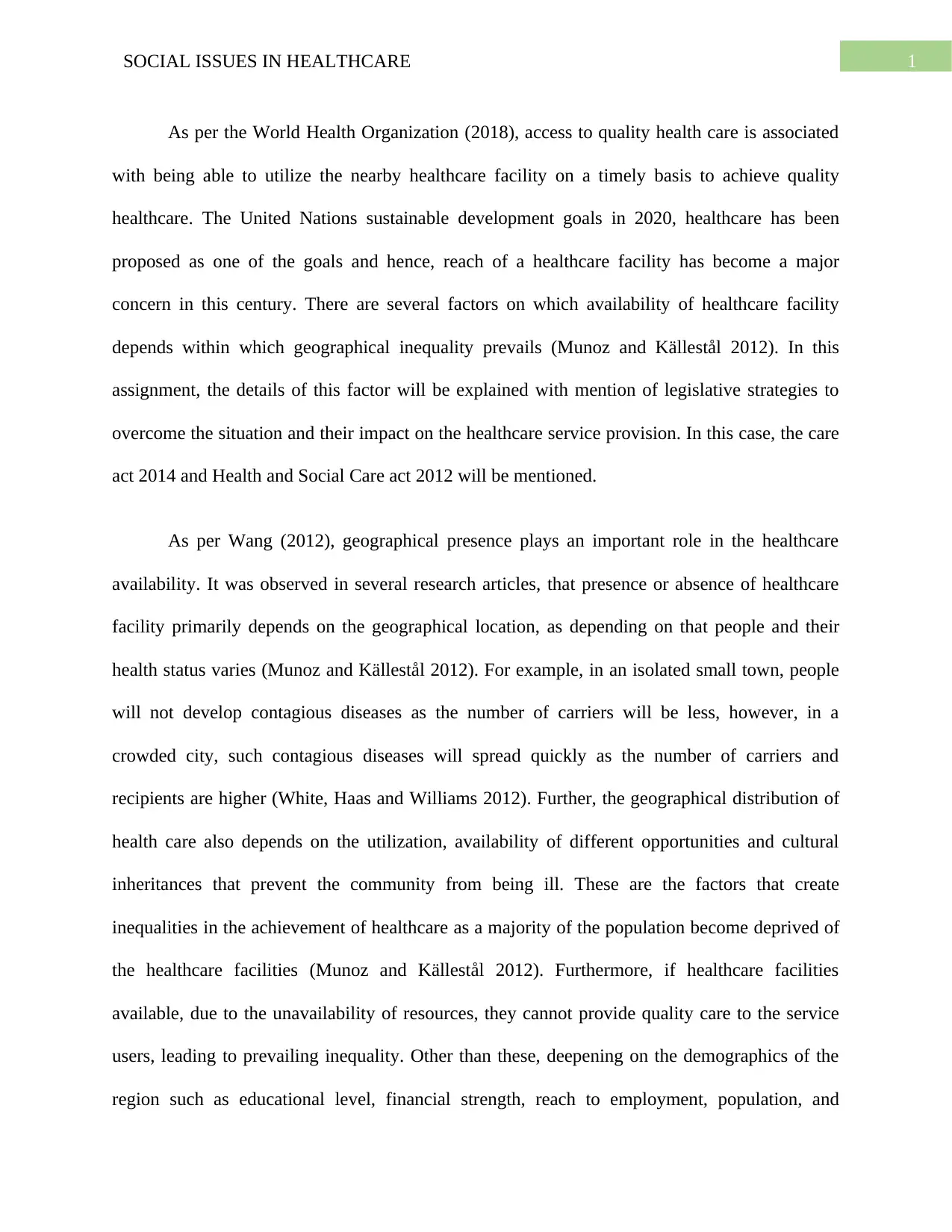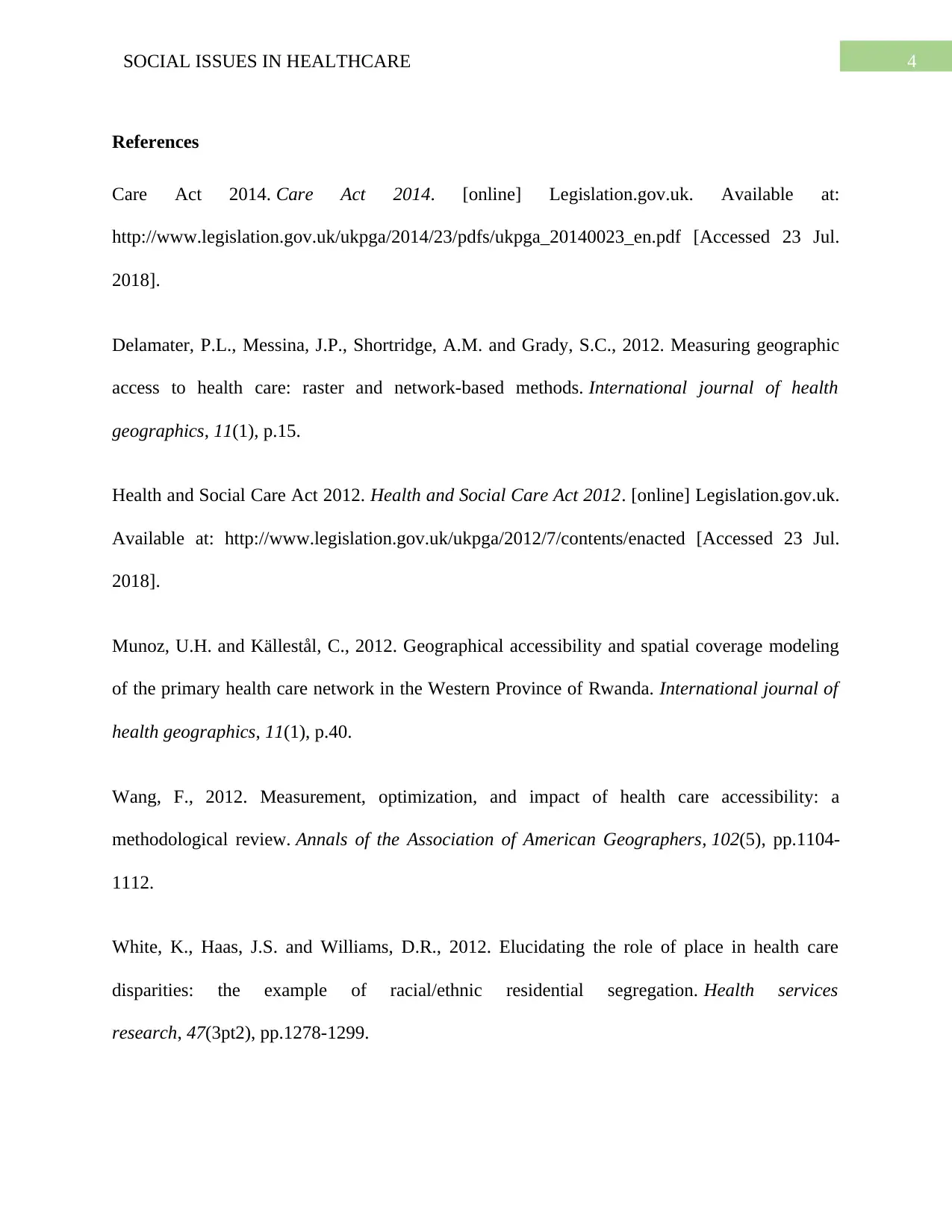Impact of Social Issues on Healthcare Service Provision
VerifiedAdded on 2023/06/09
|6
|1223
|174
Report
AI Summary
This report examines the impact of social issues on healthcare, particularly focusing on geographical inequalities and their effects on healthcare service provision. The assignment highlights how factors like location, demographics, and access to resources create disparities in healthcare availability and quality. It analyzes the role of legislation, including the Care Act 2014 and the Health and Social Care Act 2012, in addressing these inequalities. The report discusses the ethical responsibilities of healthcare providers and the government to ensure equitable access to care, irrespective of socioeconomic status or location. It references key research and reports to support its analysis, emphasizing the need for strategies to eliminate discrimination and improve health experiences for all service users. The report concludes by stressing the importance of strict implementation of legislation to ensure equitable distribution of healthcare services throughout the region.

Running head: SOCIAL ISSUES IN HEALTHCARE
HEALTH AND SOCIAL CARE ASSIGNMENT
Name of the Student
Name of the University
Author note
HEALTH AND SOCIAL CARE ASSIGNMENT
Name of the Student
Name of the University
Author note
Paraphrase This Document
Need a fresh take? Get an instant paraphrase of this document with our AI Paraphraser

1SOCIAL ISSUES IN HEALTHCARE
As per the World Health Organization (2018), access to quality health care is associated
with being able to utilize the nearby healthcare facility on a timely basis to achieve quality
healthcare. The United Nations sustainable development goals in 2020, healthcare has been
proposed as one of the goals and hence, reach of a healthcare facility has become a major
concern in this century. There are several factors on which availability of healthcare facility
depends within which geographical inequality prevails (Munoz and Källestål 2012). In this
assignment, the details of this factor will be explained with mention of legislative strategies to
overcome the situation and their impact on the healthcare service provision. In this case, the care
act 2014 and Health and Social Care act 2012 will be mentioned.
As per Wang (2012), geographical presence plays an important role in the healthcare
availability. It was observed in several research articles, that presence or absence of healthcare
facility primarily depends on the geographical location, as depending on that people and their
health status varies (Munoz and Källestål 2012). For example, in an isolated small town, people
will not develop contagious diseases as the number of carriers will be less, however, in a
crowded city, such contagious diseases will spread quickly as the number of carriers and
recipients are higher (White, Haas and Williams 2012). Further, the geographical distribution of
health care also depends on the utilization, availability of different opportunities and cultural
inheritances that prevent the community from being ill. These are the factors that create
inequalities in the achievement of healthcare as a majority of the population become deprived of
the healthcare facilities (Munoz and Källestål 2012). Furthermore, if healthcare facilities
available, due to the unavailability of resources, they cannot provide quality care to the service
users, leading to prevailing inequality. Other than these, deepening on the demographics of the
region such as educational level, financial strength, reach to employment, population, and
As per the World Health Organization (2018), access to quality health care is associated
with being able to utilize the nearby healthcare facility on a timely basis to achieve quality
healthcare. The United Nations sustainable development goals in 2020, healthcare has been
proposed as one of the goals and hence, reach of a healthcare facility has become a major
concern in this century. There are several factors on which availability of healthcare facility
depends within which geographical inequality prevails (Munoz and Källestål 2012). In this
assignment, the details of this factor will be explained with mention of legislative strategies to
overcome the situation and their impact on the healthcare service provision. In this case, the care
act 2014 and Health and Social Care act 2012 will be mentioned.
As per Wang (2012), geographical presence plays an important role in the healthcare
availability. It was observed in several research articles, that presence or absence of healthcare
facility primarily depends on the geographical location, as depending on that people and their
health status varies (Munoz and Källestål 2012). For example, in an isolated small town, people
will not develop contagious diseases as the number of carriers will be less, however, in a
crowded city, such contagious diseases will spread quickly as the number of carriers and
recipients are higher (White, Haas and Williams 2012). Further, the geographical distribution of
health care also depends on the utilization, availability of different opportunities and cultural
inheritances that prevent the community from being ill. These are the factors that create
inequalities in the achievement of healthcare as a majority of the population become deprived of
the healthcare facilities (Munoz and Källestål 2012). Furthermore, if healthcare facilities
available, due to the unavailability of resources, they cannot provide quality care to the service
users, leading to prevailing inequality. Other than these, deepening on the demographics of the
region such as educational level, financial strength, reach to employment, population, and

2SOCIAL ISSUES IN HEALTHCARE
connection with major cities, racial and cultural diversity and the community age variation
determined the availability as well as the quality of care (Delamater et al. 2012). There are
several strategies that the healthcare department of the United Kingdom has implemented to
reduce the prevalence of persisting inequality in the healthcare service. As per the equality law
2010, it is the responsibility of the local authorities to include different communities to engage in
the healthcare process and provide them with their healthcare-related rights to make the service
accessible and appropriate for everyone (White, Haas and Williams 2012).
As mentioned in the above section, with prevailing inequality present in the presence and
quality of healthcare facilities in several geographical locations, it should be noted that there are
several disadvantages are faced by the community living in such areas (Munoz and Källestål
2012). This inequality not only prevents them from receiving quality care but also make them
deprive them of their rationing and decision-making rights. The ethical principles and the
rationing of health care is a part of this discrimination, due to which, for social or financial
reasons, patients become unable to attain the quality healthcare (Delamater et al. 2012). Further,
it is also an ethical responsibility of the government and authority of healthcare facilities as per
the legislation of Health and Social Care Act 2012 to provide the healthcare service irrespective
of the location, financial strength, and socio-economic status. Besides healthcare facilities, a
number of healthcare professionals also vary depending on the geographical locations that lead
to inequality in the process (White, Haas and Williams 2012).
Besides these, there are some important law and reports that are currently followed by the
healthcare department to tackle the inequality and determine their impact on the provision of the
healthcare service. The Health and Social Care Act 2012 and the Care Act 2014 are the
connection with major cities, racial and cultural diversity and the community age variation
determined the availability as well as the quality of care (Delamater et al. 2012). There are
several strategies that the healthcare department of the United Kingdom has implemented to
reduce the prevalence of persisting inequality in the healthcare service. As per the equality law
2010, it is the responsibility of the local authorities to include different communities to engage in
the healthcare process and provide them with their healthcare-related rights to make the service
accessible and appropriate for everyone (White, Haas and Williams 2012).
As mentioned in the above section, with prevailing inequality present in the presence and
quality of healthcare facilities in several geographical locations, it should be noted that there are
several disadvantages are faced by the community living in such areas (Munoz and Källestål
2012). This inequality not only prevents them from receiving quality care but also make them
deprive them of their rationing and decision-making rights. The ethical principles and the
rationing of health care is a part of this discrimination, due to which, for social or financial
reasons, patients become unable to attain the quality healthcare (Delamater et al. 2012). Further,
it is also an ethical responsibility of the government and authority of healthcare facilities as per
the legislation of Health and Social Care Act 2012 to provide the healthcare service irrespective
of the location, financial strength, and socio-economic status. Besides healthcare facilities, a
number of healthcare professionals also vary depending on the geographical locations that lead
to inequality in the process (White, Haas and Williams 2012).
Besides these, there are some important law and reports that are currently followed by the
healthcare department to tackle the inequality and determine their impact on the provision of the
healthcare service. The Health and Social Care Act 2012 and the Care Act 2014 are the
⊘ This is a preview!⊘
Do you want full access?
Subscribe today to unlock all pages.

Trusted by 1+ million students worldwide

3SOCIAL ISSUES IN HEALTHCARE
important sections that are implemented in the healthcare sector of UK. The Health and Social
Care Act 2012 in its policy statement states that it is the responsibility of the healthcare
departments to eliminate discrimination, harassment and provide an opportunity to everyone to
attain quality healthcare (Health and Social Care Act 2012). Further the Care Act 2014 reminds
these authorities that it’s their legal duty to provide health care services to locations which are
geographically deprived so that equality in this important section can prevail. For this purpose,
they need to provide the local health authorities with ample systematic and financial support so
that they can reduce the presence of inequality in the system and can enhance the health
experiences of the service users (Care Act 2014).
While concluding this assignment it should be mentioned that it is important for
important aspects like healthcare to be equitable as there are sections in the society who are
unable to attain quality healthcare due to several geographical and financial aspects. Therefore,
the governments should implement the legislation strictly to equally distribute the service
throughout the region.
important sections that are implemented in the healthcare sector of UK. The Health and Social
Care Act 2012 in its policy statement states that it is the responsibility of the healthcare
departments to eliminate discrimination, harassment and provide an opportunity to everyone to
attain quality healthcare (Health and Social Care Act 2012). Further the Care Act 2014 reminds
these authorities that it’s their legal duty to provide health care services to locations which are
geographically deprived so that equality in this important section can prevail. For this purpose,
they need to provide the local health authorities with ample systematic and financial support so
that they can reduce the presence of inequality in the system and can enhance the health
experiences of the service users (Care Act 2014).
While concluding this assignment it should be mentioned that it is important for
important aspects like healthcare to be equitable as there are sections in the society who are
unable to attain quality healthcare due to several geographical and financial aspects. Therefore,
the governments should implement the legislation strictly to equally distribute the service
throughout the region.
Paraphrase This Document
Need a fresh take? Get an instant paraphrase of this document with our AI Paraphraser

4SOCIAL ISSUES IN HEALTHCARE
References
Care Act 2014. Care Act 2014. [online] Legislation.gov.uk. Available at:
http://www.legislation.gov.uk/ukpga/2014/23/pdfs/ukpga_20140023_en.pdf [Accessed 23 Jul.
2018].
Delamater, P.L., Messina, J.P., Shortridge, A.M. and Grady, S.C., 2012. Measuring geographic
access to health care: raster and network-based methods. International journal of health
geographics, 11(1), p.15.
Health and Social Care Act 2012. Health and Social Care Act 2012. [online] Legislation.gov.uk.
Available at: http://www.legislation.gov.uk/ukpga/2012/7/contents/enacted [Accessed 23 Jul.
2018].
Munoz, U.H. and Källestål, C., 2012. Geographical accessibility and spatial coverage modeling
of the primary health care network in the Western Province of Rwanda. International journal of
health geographics, 11(1), p.40.
Wang, F., 2012. Measurement, optimization, and impact of health care accessibility: a
methodological review. Annals of the Association of American Geographers, 102(5), pp.1104-
1112.
White, K., Haas, J.S. and Williams, D.R., 2012. Elucidating the role of place in health care
disparities: the example of racial/ethnic residential segregation. Health services
research, 47(3pt2), pp.1278-1299.
References
Care Act 2014. Care Act 2014. [online] Legislation.gov.uk. Available at:
http://www.legislation.gov.uk/ukpga/2014/23/pdfs/ukpga_20140023_en.pdf [Accessed 23 Jul.
2018].
Delamater, P.L., Messina, J.P., Shortridge, A.M. and Grady, S.C., 2012. Measuring geographic
access to health care: raster and network-based methods. International journal of health
geographics, 11(1), p.15.
Health and Social Care Act 2012. Health and Social Care Act 2012. [online] Legislation.gov.uk.
Available at: http://www.legislation.gov.uk/ukpga/2012/7/contents/enacted [Accessed 23 Jul.
2018].
Munoz, U.H. and Källestål, C., 2012. Geographical accessibility and spatial coverage modeling
of the primary health care network in the Western Province of Rwanda. International journal of
health geographics, 11(1), p.40.
Wang, F., 2012. Measurement, optimization, and impact of health care accessibility: a
methodological review. Annals of the Association of American Geographers, 102(5), pp.1104-
1112.
White, K., Haas, J.S. and Williams, D.R., 2012. Elucidating the role of place in health care
disparities: the example of racial/ethnic residential segregation. Health services
research, 47(3pt2), pp.1278-1299.

5SOCIAL ISSUES IN HEALTHCARE
World Health Organization 2018. 10 facts on health inequities and their causes. [online] World
Health Organization. Available at: http://www.who.int/features/factfiles/health_inequities/en/
[Accessed 23 Jul. 2018].
World Health Organization 2018. 10 facts on health inequities and their causes. [online] World
Health Organization. Available at: http://www.who.int/features/factfiles/health_inequities/en/
[Accessed 23 Jul. 2018].
⊘ This is a preview!⊘
Do you want full access?
Subscribe today to unlock all pages.

Trusted by 1+ million students worldwide
1 out of 6
Related Documents
Your All-in-One AI-Powered Toolkit for Academic Success.
+13062052269
info@desklib.com
Available 24*7 on WhatsApp / Email
![[object Object]](/_next/static/media/star-bottom.7253800d.svg)
Unlock your academic potential
Copyright © 2020–2025 A2Z Services. All Rights Reserved. Developed and managed by ZUCOL.





